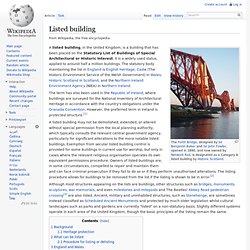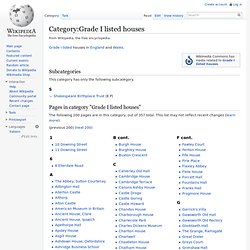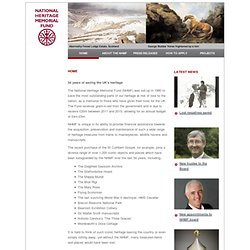

Listed building. A listed building, in the United Kingdom, is a building that has been placed on the Statutory List of Buildings of Special Architectural or Historic Interest.

It is a widely used status, applied to around half a million buildings. The statutory body maintaining the list in England is English Heritage; Cadw (The Historic Environment Service of the Welsh Government) in Wales; Historic Scotland in Scotland; and the Northern Ireland Environment Agency (NIEA) in Northern Ireland. The term has also been used in the Republic of Ireland, where buildings are surveyed for the National Inventory of Architectural Heritage in accordance with the country's obligations under the Granada Convention. However, the preferred term in Ireland is protected structure.[1] Although most structures appearing on the lists are buildings, other structures such as bridges, monuments, sculptures, war memorials, and even milestones and mileposts and The Beatles' Abbey Road pedestrian crossing[3] are also listed. Grade I. Grade I listed houses. From Wikipedia, the free encyclopedia Grade I listed houses in England and Wales.

Subcategories This category has only the following subcategory. Pages in category "Grade I listed houses" The following 200 pages are in this category, out of 357 total. (previous 200) (next 200) Grade II* Grade II. Meetings & events Tourism. VisitEngland. Domestic Tourism. North East. East Anglia. The South East England. Visit London. Public Lending Right. Arts Council England. Tyne and Wear Archives & Museums. National Heritage Memorial Fund. 34 years of saving the UK's heritage The National Heritage Memorial Fund (NHMF) was set-up in 1980 to save the most outstanding parts of our heritage at risk of loss to the nation, as a memorial to those who have given their lives for the UK.

The Fund receives grant-in-aid from the government and is due to receive £20m between 2011 and 2015, allowing for an annual budget of £4m-£5m. NHMF is unique in its ability to provide financial assistance towards the acquisition, preservation and maintenance of such a wide range of heritage treasures from trains to masterpieces, wildlife havens and manuscripts.
The recent purchase of the St Cuthbert Gospel, for example, joins a diverse range of over 1,200 iconic objects and places which have been safeguarded by the NHMF over the last 34 years, including; It is hard to think of such iconic heritage leaving the country or even simply rotting away, yet without the NHMF, many treasured items and places would have been lost. Department for Culture, Media & Sport. Treasure Valuation Committee. The Treasure Valuation Committee (TVC) is an independent body based in London, which offers expert advice to the government on items of declared treasure finds in England, Wales, and Northern Ireland that museums may wish to acquire from the Crown.[1] Finds which are found in the United Kingdom, such as the Vale of York Hoard, are valued by the TVC.

The TVC is an advisory non-departmental public body of the Department for Culture, Media and Sport (DCMS). Its terms of reference as laid down in the Treasure Act 1996 code of Practice.[2] Members[edit] The Chairman, Professor Lord Renfrew of Kaimsthorn. In September 2010, the DCMS advertised to fill the role of Medieval and Post-Medieval Coin Expert on the TVC (held by May Sinclair).[3] The successful applicant was Dr David Dykes. In January 2011, the DCMS advertised to fill the role of Chair of the TVC (held by Professor Norman Palmer since 2001).[4] As of 10 May 2011 the successful applicant was Professor Lord Colin Renfrew of Kaimsthorn.